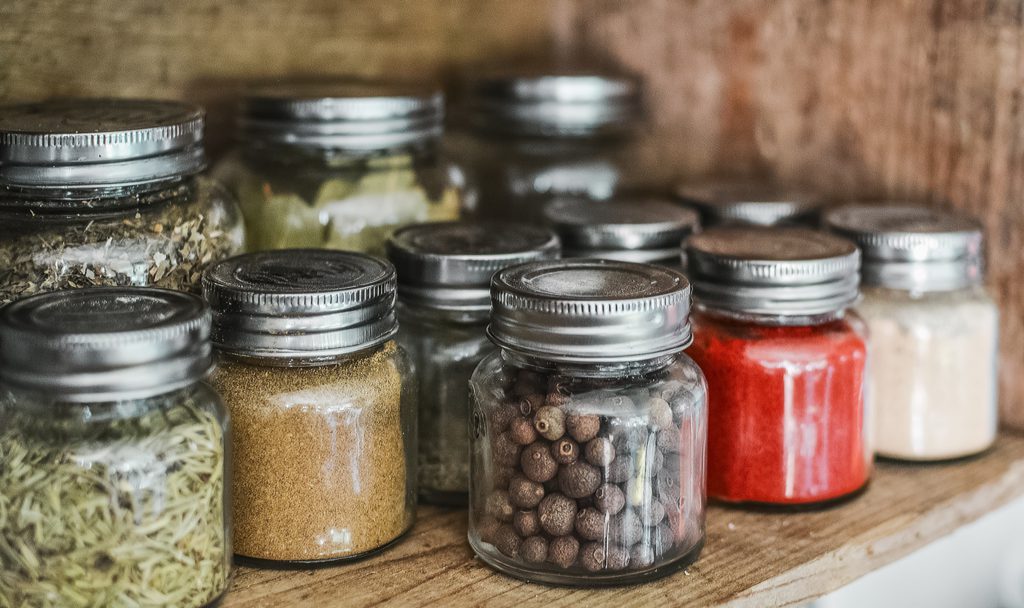
INTRO
What is a Spices Challenge?

Spices are plant-based foods that are often used to add flavor, color, and aroma to dishes. They can transform a simple dish into a complex and flavorful one, enhancing the overall eating experience.
They have been used for thousands of years in traditional medicine and cooking and are believed to have many health benefits. For example, turmeric is known for its anti-inflammatory properties, while cinnamon has been shown to lower blood sugar levels.
Starting a spice challenge with friends and family is a great way to involve someone else who might like to improve their health by eating more spices.
Benefits of Spices
Antioxidant properties
Many spices, such as turmeric and ginger, are high in antioxidants, which can help protect the body from free radicals and reduce the risk of chronic diseases such as heart disease and cancer.
Improved digestion
Certain spices, such as garlic and cloves, have antimicrobial properties and may help boost the immune system.
Immune support
Certain spices, such as garlic and cloves, have antimicrobial properties and may help boost the immune system.
Improved blood sugar control
Some spices, such as cinnamon and fenugreek, may help improve blood sugar control and may be beneficial for people with diabetes.

Anti-inflammatory effects
Some spices, such as turmeric and cinnamon, have anti-inflammatory properties, which can help reduce inflammation in the body and may be beneficial for people with conditions such as arthritis and asthma. You might consider having anti-inflammatory teas as a way to supplement these in your diet.
Enhance the Benefits of Spice

Starting a spices challenge can be a helpful addition to a detox or nutrition program, as some spices are believed to have detoxifying properties and can help support the body’s natural detoxification processes.
Here are a few key actions to consider when starting a spices challenge.
Choose spices with known detoxifying properties. Some spices that are believed to have detoxifying properties include turmeric, cumin, fennel, and ginger.
Incorporate spices into your diet. Try adding a pinch of these spices to your meals or drinks to add flavor and potential detoxifying benefits. You can also try making a detox tea by steeping a combination of these spices in hot water.
Stay hydrated. Drinking plenty of water is important for supporting the body’s natural detoxification processes. Consider adding a slice of lemon, a sprig of mint, or a pinch of a detoxifying spice to your water to add flavor and potential benefits.
Eat a balanced diet. A healthy, balanced diet is an important part of any detox program. In addition to incorporating spices, be sure to eat plenty of fruits, vegetables, and whole grains, and limit your intake of processed and sugary foods.
Get enough sleep. Consistent sleep is important for supporting the body’s natural detoxification processes. Aim for 7-9 hours of sleep per night.
Stay active. Regular physical activity can help support the body’s natural detoxification processes. Aim for at least 150 minutes of moderate-intensity activity per week, like cardio and strength training.
It’s important to note that some spices can have side effects, and some may interact with medications you are taking. It’s always a good idea to talk to a healthcare professional before using new spices and herbs.
Different Ways to Use Spice
There are a few ways that spices can be used for health beyond just adding them to food to promote health and wellness in your spices challenge. Here are a few examples:
Adding flavor to food
Spices can add flavor to food, which can help reduce the need for added sugar and salt, which are associated with a number of health problems when consumed in excess.
Tea
Inhalation
Some people find that inhaling the aroma of certain spices, such as eucalyptus or peppermint, can help alleviate respiratory issues.
Oil Infusion
Some spices can be infused into oils, which can then be used in massage or aromatherapy. For example, an infusion of ginger in a carrier oil can be used to help reduce muscle pain.
Skin care
Some spices, such as turmeric and cinnamon, can be used in homemade face masks and other skin care products to soothe acne and calm the skin

How to Start a Spice Challenge
Incorporating more spices into your cooking and lifestyle can take some getting used to, but the health benefits are totally worth it! Here are a few tips to help you get started:
1
Start small
When using new spices, it’s best to start with a small amount and gradually increase to your preferred taste. This will allow you to better control the flavor of your dish.
2
Experiment with different combinations
Try pairing different spices together to create unique flavor profiles. For example, try combining cumin, paprika, and garlic for a smoky, southwestern flavor.
3
Keep a well-stocked spice cabinet
Having a variety of spices on hand will make it easier to experiment and try new flavors. Consider investing in some basic spices like cumin, paprika, and garlic powder, as well as some more exotic options like turmeric, cardamom, and sumac.
4
Increase diversity
Increasing diversity of spices not only keeps things interesting, it also increases your health benefits. See how many different spices you can include in your cooking each week!
5
Don't be afraid to try new things
The best way to learn about spices is to experiment with them in your cooking. So don’t be afraid to try something new and see how it turns out!
Spice holding you back?

There are a few common setbacks that people may encounter when starting a spice challenge, and here are a few suggestions for how to overcome them:
Not knowing which spices to use. If you’re not sure which spices to use in your cooking, try looking for recipes that use spices you’re interested in trying. You can also ask friends or family members for recommendations, or consult a cookbook or online resource for ideas.
Using too much of a spice. If you’ve added too much of a spice to your dish, it can be difficult to fix. One option is to try and balance out the flavor with additional ingredients, such as adding more broth or tomato sauce to a spicy soup. Alternatively, you can try diluting the flavor by adding more of the other ingredients in the recipe.
Not liking the flavor of a spice. If you’ve tried a spice and didn’t like the flavor, don’t be discouraged! Not everyone likes the same flavors, and that’s okay. Just try a different spice next time.
Not being able to find a specific spice. If you’re having trouble finding a specific spice, try checking at a specialty store or online. You can also try substituting a similar spice if you’re unable to find the one you’re looking for.
Remember to be patient and keep trying new things – with time and practice, you’ll become more confident in your use of spices.
Spice Challenge FAQ's
Organizing spices can be a great way to make your kitchen more efficient and easier to navigate. Follow these steps to better organize your spices:
- Sort through your spices and check the expiration dates. Discard any expired or stale spices.
- Decide on a storage method that works for you. You can use a spice rack, drawer, or cabinet. Some people prefer to use clear containers or labels to make it easier to find specific spices.
- Group your spices by type or use. For example, you can group all baking spices like cinnamon, nutmeg, and allspice together. Similarly, you can group all Indian spices like cumin, coriander, and turmeric together.
- Arrange your spices in alphabetical order or in the order you use them most frequently.
- Label your spices clearly to make it easier to find what you need. You can use a label maker or write on the container with a permanent marker.
- Store your spices in a cool, dry place away from sunlight to maintain their flavor and freshness.
By following these steps, you can have a well-organized spice collection that is easy to navigate and use in your cooking.
Building spice tolerance can take some time and patience, but here are some tips that may help:
- Start Slow. Start with mild spices and gradually increase the level of heat as your tolerance builds up. This can help your taste buds adjust gradually to the spiciness.
- Mix spices with foods. Mix spicy spices with foods that have a neutral or sweet taste, such as rice, bread, or yogurt. This can help balance the spiciness and make it more palatable.
- Try different types of spices. Experiment with different types of spices, such as cumin, paprika, coriander, and ginger. Each spice has its unique flavor and heat level, and exploring different spices can help you build a more diverse palate.
- Don’t overdo It. It’s important to listen to your body and not push yourself too hard. If you start to feel uncomfortable or experience any negative symptoms like heartburn or upset stomach, it’s a sign to take a break or reduce the spice level.
- Be consistent. Consistency is key when it comes to building spice tolerance. Try incorporating a small amount of spicy food into your diet on a regular basis. Over time, your taste buds will become accustomed to the heat.
Remember, building spice tolerance is a gradual process and may take time. Be patient with yourself and enjoy the journey of exploring new flavors and building your palate.
Spices can enhance the flavor of any dish and bring out its unique taste. Here are just a few examples of spices that can be used to enhance the flavor of different types of food.
- Beef. Black pepper, cumin, garlic, rosemary, thyme, paprika, chili powder, coriander.
- Chicken. Cumin, coriander, paprika, turmeric, ginger, thyme, rosemary, garlic, oregano.
- Fish. Dill, fennel, lemon pepper, cumin, coriander, parsley, garlic, paprika.
- Pork. Cumin, garlic, thyme, rosemary, sage, paprika, chili powder.
- Vegetables. Cumin, coriander, turmeric, paprika, garlic, ginger, cinnamon, cayenne pepper.
- Rice and grains. Cumin, turmeric, coriander, cinnamon, cardamom, cloves.
- Soups and stews. Cumin, coriander, turmeric, chili powder, paprika, thyme, rosemary.
- Salads. Basil, oregano, thyme, parsley, rosemary, garlic, black pepper, lemon juice.
- Baked goods. Cinnamon, nutmeg, ginger, allspice, cloves, cardamom.
Experimenting with different spices and combinations can lead to discovering new and exciting flavor combinations.
Spices can lose their flavor and potency over time, and in some cases, they can even go bad. Here are some signs that a spice may have gone bad:
Smell. If the spice has lost its characteristic aroma or has a musty or moldy smell, it may have gone bad.
Taste. If the spice tastes bland or has an off flavor, it may have lost its potency and may not be good to use.
Appearance. If the spice has changed color, has developed clumps, or has moisture in the container, it may have gone bad.
Expiration date. Check the expiration date on the spice container. If the spice has passed its expiration date, it may have lost its potency and could be unsafe to consume.
Storage. Improper storage can cause spices to go bad quickly. If the spice has been exposed to prolonged heat, light, or moisture, it may have gone bad.
Insects. If you notice any signs of insects or pests in the spice container, it’s best to discard it.
It’s important to remember that spices don’t necessarily go bad in the sense that they become dangerous to consume, but they may lose their flavor and potency, making them less effective for cooking. To ensure that your spices stay fresh, store them in a cool, dry, and dark place and avoid keeping them near a stove or other sources of heat. Additionally, try to use spices within 6 to 12 months of opening to ensure optimal freshness and flavor.
Spice Things up!
Here are a few tools that can support your spices challenge and your habit of using more spices for your health.
Meal planning. Planning out your meals for the week in advance can help you decide which spices you want to use and ensure that you have them on hand when you’re ready to cook.
Stocking your pantry. Keeping a well-stocked pantry with a variety of spices will make it easier for you to use them in your cooking.
A spice rack. Consider investing in a spice rack with some basic spices like cumin, paprika, and garlic powder, as well as some more exotic options like turmeric, cardamom, and sumac.
Using spice blends. Spice blends, such as curry powders or Italian seasoning, can be a convenient way to add flavor to your cooking. These blends are typically made up of a combination of spices, so you can add a variety of flavors to your dishes with just one ingredient.
Following recipes. Looking for recipes that feature spices can be a great way to get inspiration and try new flavor combinations. You can find recipes online, in apps, in cookbooks, or by asking friends and family for recommendations.










